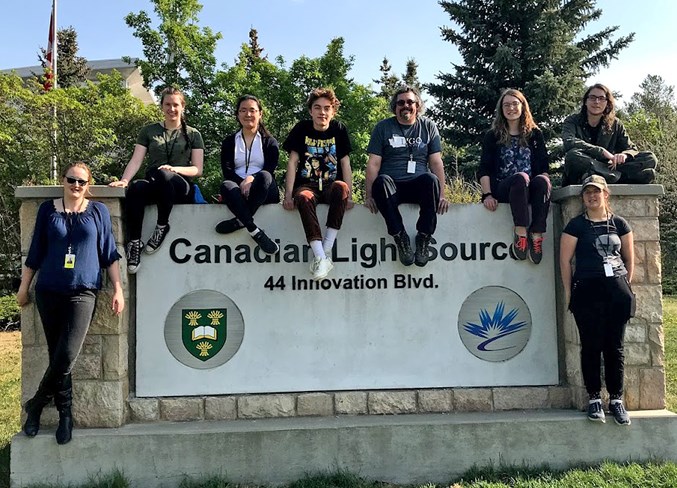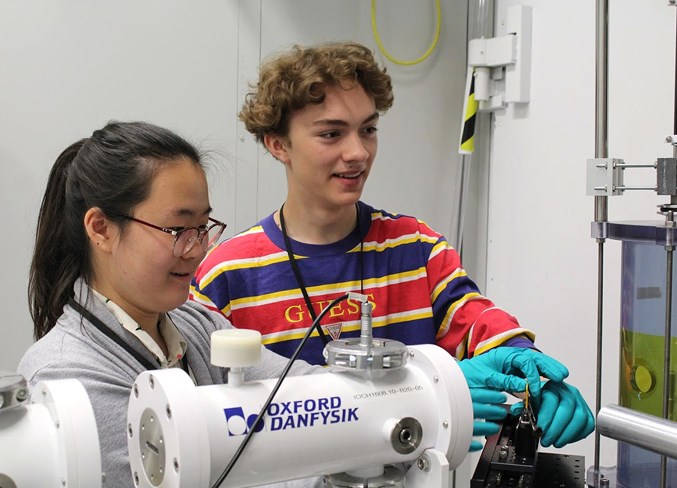Learning about science by reading books is a good start, but only goes so far.
Much like anything else in life, arguably the best way to develop a more intimate knowledge and understanding involves a hands-on approach.
A group of seven Sundre High School students recently went to the Canadian Light Source at the University of Saskatchewan campus in Saskatoon, home of one of the brightest X-Ray sources in the world, to conduct experiments.
They tested a hypothesis they developed to investigate fungal remediation of hexavalent chromium in soil that has been contaminated by ash from chromated copper arsenate (CCA) pressure treated lumber, said Ryan Beck, a science teacher at Sundre High School.
“This contamination is a problem when wildfires burn pressure treated decks and fences,” said Beck.
“For example, in Fort Mac, many gardens were contaminated with toxic hexavalent chromium after the wildfire there,” he said.
Fungal remediation has the potential to be a more environmentally friendly way to treat such contamination than existing methods and could also be more affordable while additionally introducing fewer new chemicals into the soil. Of course the key word being “could,” which is what in large part inspires the students and drives their research, he said, adding they are not in a qualified position to definitely assert the claims.
The students explored a particular application of fungal remediation that had never before been tested, he said.
“Even if the experiment is successful, we won’t be able to provide advice to people on trying to apply or use this treatment. It would simply be an indication that further research on the safety and efficacy of this treatment is warranted.”
Over the past 14 months, the group designed and conducted the experiment on their own with minimal guidance, and Beck said he and the students were enthusiastic about collecting the data to determine whether their hypothesis would be supported.
 A group of seven Sundre High School students participated in a 14-month endeavour to develop and conduct an experiment studying fungal remediation of hexavalent chromium in soil that has been contaminated by ash from chromated copper arsenate (CCA) pressure treated lumber, culminating in a recent trip to the Canadian Light Source at the University of Saskatchewan campus in Saskatoon. Submitted photo
A group of seven Sundre High School students participated in a 14-month endeavour to develop and conduct an experiment studying fungal remediation of hexavalent chromium in soil that has been contaminated by ash from chromated copper arsenate (CCA) pressure treated lumber, culminating in a recent trip to the Canadian Light Source at the University of Saskatchewan campus in Saskatoon. Submitted photo
“In our results, we didn’t find any measurable effects because we actually didn’t get any hexavalent chromium in the first place,” said Lawsen Augustowich, a Grade 10 student.
“But the whole thing was really reflective of the scientific process, even though we couldn’t prove or disprove our hypothesis,” said Augustowich, adding that science is not always just about proving or disproving something but also about building the body of data available on a subject.
Initially he said he got involved because the experience would reflect positively on a university application but he added, “It very quickly became something more. I made a really meaningful connection with everybody involved and the opportunity to actually do real scientific research outside of school was really appealing to me.”
Although he intends to eventually pursue a major in arts, Augustowich said the experience was rewarding and offered insight on the field of science, which involves more than conducting experiments.
“There were some English majors there. It’s a big facility, so there are a lot of people, even in communications,” he said, expressing gratitude for the support of Beck as well as biology teacher Kevin Challoner and all of the staff at Canadian Light Source who helped facilitate the endeavour.
“It was so great and I learned so much.”
The experiment was not about taking a stand on CCA treated lumber, said Beck.
“We are just following up on previous research and are interested in what the data tells us,” he said, adding the chemically treated wood is already banned for residential use.
“The very small amount that is produced today for commercial and industrial use is not what the students are concerned about. Their concern centres around existing residential structures.”
Prior to the ban in the early 2000s, more than 80 per cent of residential outdoor lumber was treated with CCA, he said.
“That lumber has a 30- to 50-year lifespan, so wildfires burning residential fences and decks will be a concern for many years to come. Most research on CCA lumber ended after the ban, but the students feel that further research is required given the continued risk, particularly as climate change is contributing to more frequent and more intense wildfires.”
The experiment is about expanding knowledge and understanding, not about bashing industry, said Beck, adding the students emphasize the importance that West Fraser plays in the community and local economy whenever they do a presentation.
The experiment and trip to Canadian Light Source had a budget of $4,000, of which $500 came from West Fraser, with the National Science and Engineering Council providing most of the rest, said Beck, adding the Sundre and District Lions Club also contributed.
Throughout the 14 months, the students developed a greater appreciation of what the scientific process entails and their experiment and corresponding data set indicates that further research is warranted, he said.
“The transition from a hypothesis to a theory is a very long road indeed. Though many of us have our own 'theories,' this word means something very different to scientists, and the phrase ‘just a theory’ is an unfortunate depreciation of the lifetimes of toiling that have gone into building the theory,” he said.
The students learned that a statement such as “our research supports our hypothesis” in the world of science carries a lot of weight, he said.
“This leads to a new understanding of what it means when we see things like ‘more then 20,000 scientific studies conclude that humans are the primary cause of climate change,'" he said.
The teacher praised his students’ science abilities, “but they also had to develop skills in writing, presenting, graphic design and math to pull this project off. Most importantly, these students have developed lifelong skills like team building, problem solving, self-confidence, and perseverance that have become part of who they are.”
Davina Choi, a Grade 12 student who was among the group that in 2017 studied the impact of PCBs on the bone density of polar bears, was compelled by that initial experience to continue pursuing a path in science.
“The one part I really enjoyed the most was being able to encourage people and help my teammates a lot,” said Choi.
With graduation just around the corner, Choi said she will begin studying in the fall for a combined science and education degree at the University of Calgary with the goal of becoming an educator, as her experience inspired a desire to foster an interest to study science in future generations.
“And hopefully one day, I will become like Mr. Beck, and bring my students to Canadian Light Source, or something along those lines.”



